Assessing the Potential Distribution of the Traditional Chinese Medicinal Plant Spatholobus suberectus in China Under Climate Change: A Biomod2 Ensemble Model-Based Study
Simple Summary
Abstract
1. Introduction
2. Materials and Methods
2.1. Acquisition and Screening of Species Distribution Data
2.2. Acquisition and Screening of Environmental Data
2.3. Model Construction and Evaluation of Combined Model Accuracy
3. Results
3.1. Model Evaluation
3.2. Selection of Environmental Factors and Contribution Rate Analysis
3.3. Potential Distribution of Suitable Habitat for S. suberectus in the Current Period
3.4. Potential Distribution of Suitable Habitat for S. suberectus in Future Periods
3.5. Area Changes of Suitable Habitat for S. suberectus in Future Periods
3.6. Changes in the Suitable Habitat Centroid for S. suberectus in the Future
4. Discussion
4.1. Evaluation of the Combined Model Performance
4.2. Influence of Environmental Factors on the Geographical Distribution of S. suberectus
4.3. Future Changes in the Potential Suitable Distribution Areas of S. suberectus
4.4. Optimization of Cultivation Zoning for S. suberectus in China Under Climate Change Scenarios
5. Conclusions
Author Contributions
Funding
Institutional Review Board Statement
Informed Consent Statement
Data Availability Statement
Conflicts of Interest
Appendix A
| Epoch | Low-Suitability Habitat (×103 km2) | Moderate-Suitability Habitat (×103 km2) | High-Suitability Habitat (×103 km2) |
|---|---|---|---|
| Current | 493.97 | 285.93 | 22.552 |
| SSP1-2.6 2050S | 948.17 | 363.75 | 258.05 |
| SSP1-2.6 2070S | 911.89 | 320.15 | 247.58 |
| SSP1-2.6 2090S | 1027.08 | 334.02 | 245.95 |
| SSP2-4.5 2050S | 1043.92 | 360.41 | 258.66 |
| SSP2-4.5 2070S | 1207.60 | 386.84 | 249.91 |
| SSP2-4.5 2090S | 1331.57 | 423.99 | 258.78 |
| SSP5-8.5 2050S | 1194.47 | 353.42 | 256.30 |
| SSP5-8.5 2070S | 1456.96 | 403.35 | 262.96 |
| SSP5-8.5 2090S | 1598.92 | 434.87 | 261.94 |
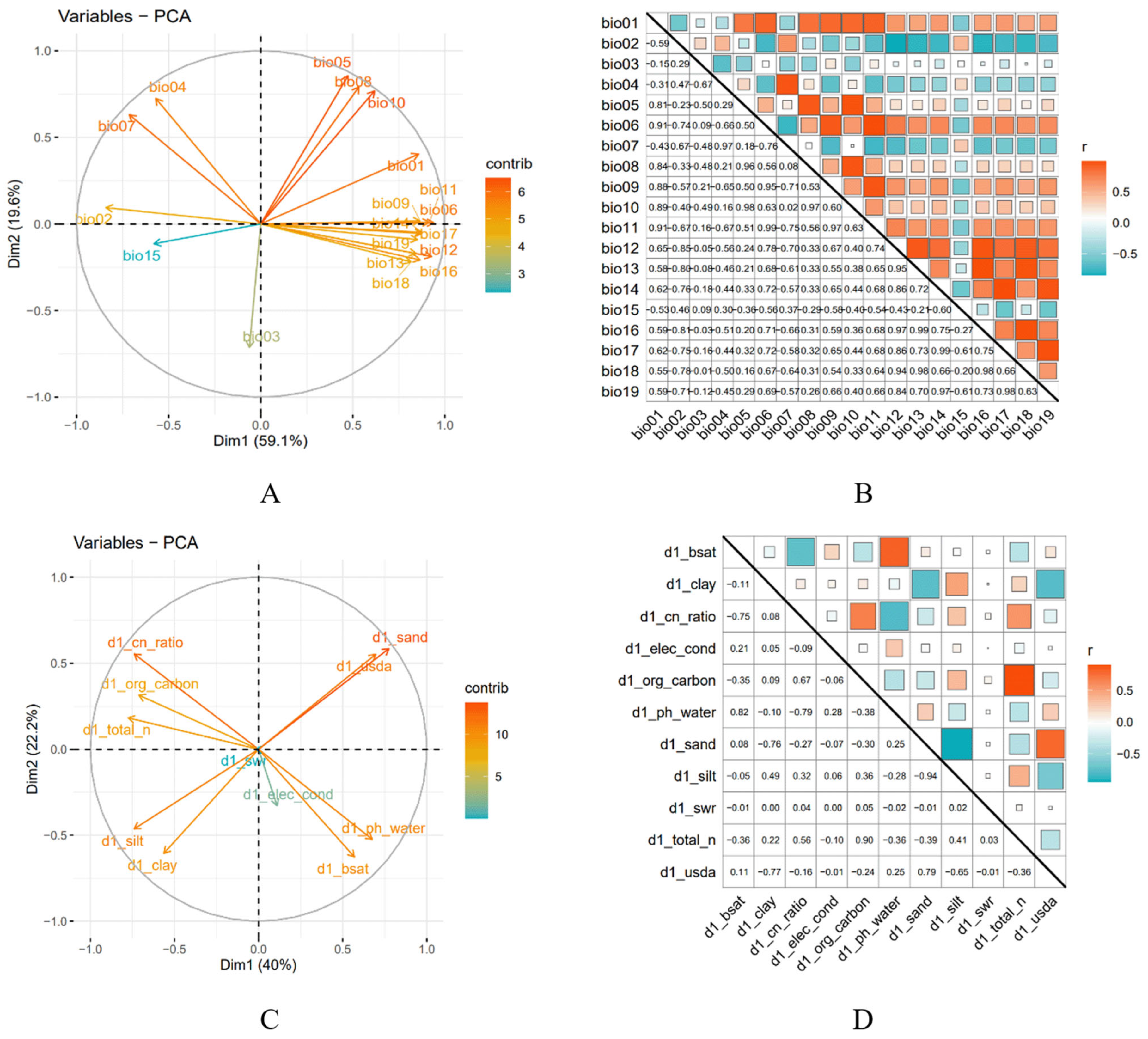
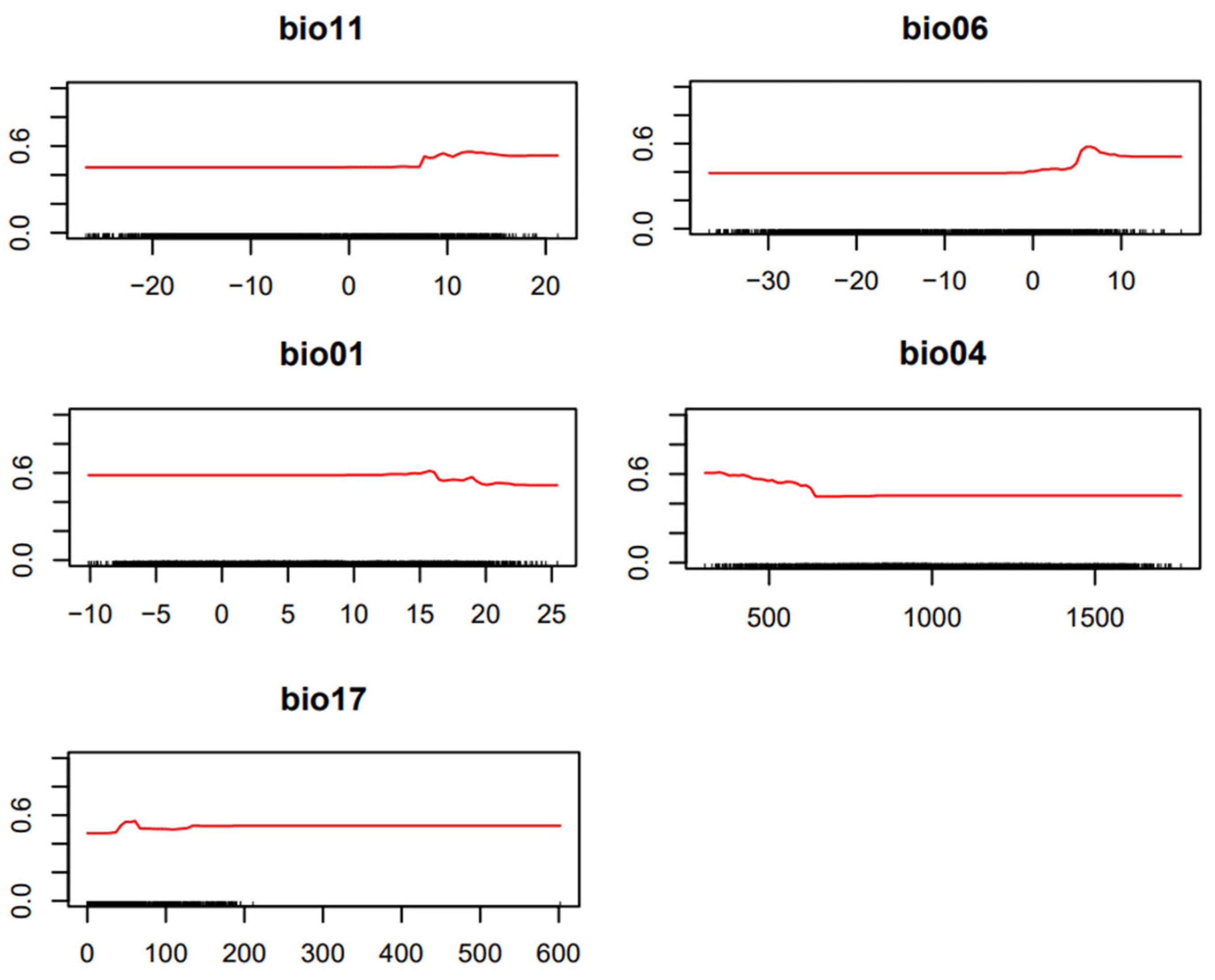
References
- Hieu, N.N.; Van Tuan, V.; Tung, P.H.T.; Le, D.Q.; Tung, N.H. Ethnopharmacology, Phytochemistry, and Pharmacological Activities of Spatholobus suberectus Vine Stem. Nat. Prod. Commun. 2022, 17, 1934578X221142724. [Google Scholar] [CrossRef]
- Editorial Committee of Flora of China. Flora of China; Science Press: Beijing, China, 1987; Volume 42, pp. 1–192. [Google Scholar]
- Xia, C.; Zhao, Y.; Liu, C.; Gao, Y. Diversity of fungal community and quality evaluation of Spatholobus Suberectus Dunn during the process of mildew. AMB Express 2024, 14, 12. [Google Scholar] [CrossRef] [PubMed]
- Zhang, F.; Ganesan, K.; Liu, Q.; Chen, J. A review of the pharmacological potential of Spatholobus suberectus Dunn on cancer. Cells 2022, 11, 2885. [Google Scholar] [CrossRef] [PubMed]
- Bo, F.; Guijae, Y.; Jun, L.P.; Yinda, Q.; Hoon, L.S.; Min, Y.H.; Namki, C. Network Pharmacology-Based Strategyto Investigate the Anti-Breast CancerMechanisms of Spatholobus suberectus Dunn. Nat. Prod. Commun. 2022, 17, 1934578X2210778. [Google Scholar]
- Pang, J.; Guo, J.; Jin, M.; Chen, Z.; Wang, X.; Li, J. Antiviral effects of aqueous extract from Spatholobus suberectus Dunn. against coxsackievirus B3 in mice. Chin. J. Integr. Med. 2011, 17, 764–769. [Google Scholar] [CrossRef] [PubMed]
- Chen, S.; Wang, A.; Lin, L.; Qiu, H.; Wang, Y.; Wang, Y. In vitro study on anti-hepatitis C virus activity of Spatholobus suberectus Dunn. Molecules 2016, 21, 1367. [Google Scholar] [CrossRef] [PubMed]
- Liu, X.; Zhang, Y.; Yang, X.; Yang, Y.; Xu, W.; Zhao, W.; Peng, K.; Gong, Y.; Liu, N.; Zhang, P. Anti-inflammatory activity of some characteristic constituents from the vine stems of Spatholobus suberectus. Molecules 2019, 24, 3750. [Google Scholar] [CrossRef]
- Huang, X.; Fei, Q.; Yu, S.; Liu, S.; Zhang, L.; Chen, X.; Cao, L.; Wang, Z.; Shan, M. A comprehensive review: Botany, phytochemistry, traditional uses, pharmacology, and toxicology of Spatholobus suberectus vine stems. J. Ethnopharmacol. 2023, 312, 116500. [Google Scholar] [CrossRef] [PubMed]
- Liu, Y.; Dai, S.; Xu, Y.; Xiang, Y.; Zhang, Y.; Xu, Z.; Sun, L.; Zhang, G.C.X.; Shu, Q. Integration of Network Pharmacology and Experimental Validation to Explore Jixueteng—Yinyanghuo Herb Pair Alleviate Cisplatin-Induced Myelosuppression. Integr. Cancer Ther. 2024, 23, 1573553105. [Google Scholar] [CrossRef]
- Shuyu, Z.; Ting, Y.; Xiaomei, L.; Hong, L.; Yuying, Z. Interactions between thrombin and natural products of Millettia speciosa Champ. using capillary zone electrophoresis. Electrophoresis 2008, 29, 3391–3397. [Google Scholar] [CrossRef] [PubMed]
- Chen, J.; Huilian, H.; Yuqin, H.E.; Ling, Z. Chemical constituents from the stem of Callerya nitida Benth. var. hirsutissima Z. Wei. J. China Pharm. Univ. 2021, 52, 177–185. [Google Scholar]
- Wruck, C.J.; Claussen, M.; Fuhrmann, G.; Romer, L.; Schulz, A.; Pufe, T.; Waetzig, V.; Peipp, M.; Herdegen, T.; Gotz, M.E. Luteolin Protects Rat PC 12 and C6 Cells Against MPP+ Induced Toxicity via an ERK Dependent Keapl-Nrf2-ARE Pathway; Springer: Berlin/Heidelberg, Germany, 2007. [Google Scholar]
- Lee, H.; Kim, M.; Han, J. Alleviating effects of lupeol on postprandial hyperglycemia in diabetic mice. Toxicol. Res. 2021, 10, 495–500. [Google Scholar] [CrossRef]
- Ma, X.; Dong, S.; Zhang, S.; Jia, N.; Ou, S. Taraxerone triterpene inhibits cancer cell growth by inducing apoptosis in non-small cell lung cancer cells. Bangladesh J. Pharmacol. 2016, 11, 342–347. [Google Scholar] [CrossRef]
- Senner, N.R.; Stager, M.; Cheviron, Z.A. Spatial and temporal heterogeneity in climate change limits species’ dispersal capabilities and adaptive potential. Ecography 2018, 41, 1428–1440. [Google Scholar] [CrossRef]
- Quisthoudt, K.; Adams, J.; Rajkaran, A.; Dahdouh-Guebas, F.; Koedam, N.; Randin, C.F. Disentangling the effects of global climate and regional land-use change on the current and future distribution of mangroves in South Africa. Biodivers. Conserv. 2013, 22, 1369–1390. [Google Scholar] [CrossRef]
- Kurpis, J.; Serrato-Cruz, M.A.; Arroyo, T.P.F. Modeling the effects of climate change on the distribution of Tagetes lucida Cav. (Asteraceae). Glob. Ecol. Conserv. 2019, 20, e747. [Google Scholar] [CrossRef]
- Zhao, G.; Cui, X.; Sun, J.; Li, T.; Wang, Q.I.; Ye, X.; Fan, B. Analysis of the distribution pattern of Chinese Ziziphus jujuba under climate change based on optimized biomod2 and MaxEnt models. Ecol. Indic. 2021, 132, 108256. [Google Scholar] [CrossRef]
- Xie, P.; Gu, Y.; Sui, W.; Tao, G.; Sun, S. Big data challenges for species distribution models in predicting potential distribution of marine species. Mar. Inf. 2019, 34, 51–61. [Google Scholar]
- Phillips, S.J.; Anderson, R.P.; Schapire, R.E. Maximum entropy modeling of species geographic distributions. Ecol. Model. 2006, 190, 231–259. [Google Scholar] [CrossRef]
- Song, H.M.; Zhang, Q.F.; Han, X.M.; Xu, P.; Xu, R.M. CLIMEX: Professional biological software for predicting potential distribution of species. Entomol. Knowl. 2004, 41, 379–386. [Google Scholar]
- Hirzel, A.H.; Hausser, J.; Chessel, D.; Perrin, N. Ecological-Niche Factor Analysis: How to Compute Habitat-Suitability Maps without Absence Data? Ecology 2002, 83, 2027–2036. [Google Scholar] [CrossRef]
- Gu, R.; Wei, S.; Li, J.; Zhwng, S.; Li, Z.; Liu, G.; Fan, S. Predicting the impacts of climate change on the geographic distribution of moso bamboo in China based on biomod2 model. Eur. J. For. Res. 2024, 143, 1499–1512. [Google Scholar] [CrossRef]
- Guisan, A.; Edwards, T.C., Jr.; Hastie, T. Generalized linear and generalized additive models in studies of species distributions: Setting the scene. Ecol. Model. 2002, 157, 89–100. [Google Scholar] [CrossRef]
- Elith, J.; Leathwick, J.R.; Hastie, T. A working guide to boosted regression trees. J. Anim. Ecol. 2008, 77, 802–813. [Google Scholar] [CrossRef]
- Thuiller, W.; Araújo, M.B.; Lavorel, S. Generalized models vs. classification tree analysis: Predicting spatial distributions of plant species at different scales. J. Veg. Sci. 2003, 14, 669–680. [Google Scholar] [CrossRef]
- Jinming, Z.; Yi, H.; Sung-Sau, S. Overview of artificial neural networks. Methods Mol. Biol. 2008, 458, 15–23. [Google Scholar]
- Booth, T.H.; Nix, H.A.; Hutchinson, M.F.; Jovanic, T. Niche analysis and tree species introduction. For. Ecol. Manag. 1988, 23, 47–59. [Google Scholar] [CrossRef]
- Hastie, T.; Tibshirani, R.; Buja, A. Flexible Discriminant Analysis by Optimal Scoring. J. Am. Stat. Assoc. 2012, 89, 1255–1270. [Google Scholar] [CrossRef]
- Sekulic, S.; Kowalski, B.R. MARS—A TUTORIAL. J. Chemom. 1992, 6, 199–216. [Google Scholar] [CrossRef]
- Breiman, L. Random Forests. Mach. Learn. 2001, 45, 5–32. [Google Scholar] [CrossRef]
- Thuiller, W.; Lafourcade, B.; Engler, R.; Araújo, M.B. BIOMOD–a platform for ensemble forecasting of species distributions. Ecography 2009, 32, 369–373. [Google Scholar] [CrossRef]
- Hao, T.; Elith, J.; Guillera Arroita, G.; Lahoz-Monfort, J.J. A review of evidence about use and performance of species distribution modelling ensembles like BIOMOD. Divers. Distrib. 2019, 25, 839–852. [Google Scholar] [CrossRef]
- Chang, B.; Huang, C.; Chen, B.; Wang, Z.; He, X.; Chen, W.; Huang, Y.; Zhang, Y.; Yu, S. Predicting the potential distribution of Taxus cuspidata in northeastern China based on the ensemble model. Ecosphere 2024, 15, e4965. [Google Scholar] [CrossRef]
- McLaughlin, S.P. Floristic plant geography: The classification of floristic areas and floristic elements. Prog. Phys. Geogr. 1994, 18, 185–208. [Google Scholar] [CrossRef]
- Velazco, S.J.E.; Rose, M.B.; de Andrade, A.F.A.; Minoli, I.; Franklin, J. Flexsdm: An R package for supporting a comprehensive and flexible species distribution modelling workflow. Methods Ecol. Evol. 2022, 13, 1661–1669. [Google Scholar] [CrossRef]
- Barbet-Massin, M.; Jiguet, F.; Albert, C.H.; Thuiller, W. Selecting pseudo-absences for species distribution models: How, where and how many? Methods Ecol. Evol. 2012, 3, 327–338. [Google Scholar] [CrossRef]
- Bebber, D.P.; Field, E.; Gui, H.; Mortimer, P.; Holmes, T.; Gurr, S. Many unreported crop pests and pathogens are probably already present. Glob. Change Biol. 2019, 25, 2703–2713. [Google Scholar] [CrossRef] [PubMed]
- Pan, Y.; Guan, Y.; Lv, S.; Huang, X.; Lin, Y.; Wei, C.; Xu, D. Assessing the Potential Distribution of Lonicera japonica in China Under Climate Change: A Biomod2 Ensemble Model-Based Study. Agriculture 2025, 15, 393. [Google Scholar] [CrossRef]
- Araújo, M.B.; New, M. Ensemble forecasting of species distributions. Trends Ecol. Evol. 2007, 22, 42–47. [Google Scholar] [CrossRef]
- Hao, T.; Elith, J.; Lahoz-Monfort, J.J.; Guillera-Arroita, G. Testing whether ensemble modelling is advantageous for maximising predictive performance of species distribution models. Ecography 2020, 43, 549–558. [Google Scholar] [CrossRef]
- Valavi, R.; Guillera-Arroita, G.; Lahoz-Monfort, J.J.; Elith, J. Predictive performance of presence-only species distribution models: A benchmark study with reproducible code. Ecol. Monogr. 2022, 92, e1486. [Google Scholar] [CrossRef]
- Li, R.; Hu, X.; Li, Q.; Liu, L.; He, Y.; Chen, C. Gap analysis of Firmiana danxiaensis, a rare tree species endemic to southern China. Ecol. Indic. 2024, 158, 111606. [Google Scholar] [CrossRef]
- Wisz, M.S.; Guisan, A. Do pseudo-absence selection strategies influence species distribution models and their predictions? An information-theoretic approach based on simulated data. BMC Ecol. 2009, 9, 8. [Google Scholar] [CrossRef]
- Chefaoui, R.M.; Lobo, J.M. Assessing the effects of pseudo-absences on predictive distribution model performance. Ecol. Model. 2008, 210, 478–486. [Google Scholar] [CrossRef]
- Guo, Y.; Wang, S.; Xu, Y.; Liu, Y.; Yan, X.; Wang, Y. Maternal effects of human-mediated disturbances on the growth and reproductive traits of different ecotypes of an annual invasive plant Erigeron annuus. Environ. Exp. Bot. 2024, 218, 105588. [Google Scholar] [CrossRef]
- Lopez, B.E.; Urban, D.; White, P.S. Testing the effects of four urbanization filters on forest plant taxonomic, functional, and phylogenetic diversity. Ecol. Appl. 2018, 28, 2197–2205. [Google Scholar] [CrossRef]
- Johnson, M.A.; Kumar, M.; Thakur, S. Effect of Variation in Temperature and Light Duration on Morpho-physiology and Phytochemical Content in Sprouts and Microgreens of Common Buckwheat (Fagopyrum esculentum Moench). Plant Foods Hum. Nutr. 2024, 79, 875–885. [Google Scholar] [CrossRef] [PubMed]
- Guo, H.; Sun, Y.; Peng, X.; Wang, Q.; Marvin, H. Up-regulation of abscisic acid signaling pathway facilitates aphid xylem absorption and osmoregulation under drought stress. J. Exp. Bot. 2016, 67, 681–693. [Google Scholar] [CrossRef]
- Wang, H.; Bai, W.; Hu, Z.; Lin, S.; Ge, Q. Effectiveness of freezing temperatures on dormancy release of temperate woody species. Ann. Bot. 2024, 134, 615–630. [Google Scholar]
- Moustafa, A.E.A.; Zayed, A. Effect of environmental factors on the flora of alluvial fans in southern Sinai. J. Arid. Environ. 1996, 32, 431–443. [Google Scholar] [CrossRef]
- Kim, J.S.; Kidokoro, S.; Yamaguchi-Shinozaki, K.; Shinozaki, K. Regulatory networks in plant responses to drought and cold stress. Plant Physiol. 2024, 195, 170–189. [Google Scholar] [CrossRef] [PubMed]
- Wang, X.; Song, Q.; Liu, Y.; Marian, B.; Yang, X. The network centered on ICEs play roles in plant cold tolerance, growth and development. Planta 2022, 255, 81. [Google Scholar] [CrossRef]
- Ramezan, D.; Zargar, M.; Nakhaev, M.R.; Akhmadovich, K.A.; Bayat, M.; Ghaderi, A. Selenium alleviates growth characteristics, plant pigments, photosynthetic and antioxidant capacity of basil (Ocimum basilicum L.) under low temperature. Biocatal. Agric. Biotechnol. 2024, 58, 103198. [Google Scholar] [CrossRef]
- Nievola, C.C.; Carvalho, C.P.; Carvalho, V.; Rodrigues, E. Rapid responses of plants to temperature changes. Temperature 2017, 4, 371–405. [Google Scholar] [CrossRef] [PubMed]
- Hasanuzzaman, M.; Nahar, K.; Alam, M.M.; Roychowdhury, R.; Fujita, M. Physiological, biochemical, and molecular mechanisms of heat stress tolerance in plants. Int. J. Mol. Sci. 2013, 14, 9643–9684. [Google Scholar] [CrossRef]
- Szymańska, R.; Ślesak, I.; Orzechowska, A.; Kruk, J. Physiological and biochemical responses to high light and temperature stress in plants. Environ. Exp. Bot. 2017, 139, 165–177. [Google Scholar] [CrossRef]
- Ma, Z.; Ren, J.; Chen, H.; Jiang, H.; Gao, Q.; Liu, S.; Yan, W.; Li, Z. Analysis and recommendations of IPCC working group. Res. Environ. Sci. 2022, 35, 2550–2558. [Google Scholar]
- Lenoir, J.; Gégout, J.C.; Marquet, P.A.; de Ruffray, P.; Brisse, H. A Significant Upward Shift in Plant Species Optimum Elevation During the 20th Century. Science 2008, 320, 1768–1771. [Google Scholar] [CrossRef]
- Schai-Braun, S.C.; Jenny, H.; Ruf, T.; Hackländer, K. Temperature increase and frost decrease driving upslope elevational range shifts in Alpine grouse and hares. Glob. Change Biol. 2021, 27, 6602–6614. [Google Scholar] [CrossRef]
- Zhao, G.; Cui, X.; Wang, Z.; Jing, H.; Fan, B. Prediction of Potential Distribution of Ziziphus jujuba var. spinosa in China under Context of Climate Change. Sci. Silvae Sin. 2021, 57, 158–168. [Google Scholar]
- Thuiller, W.; Lavorel, S.; Araujo, M.B.; Sykes, M.T.; Prentice, I.C. Climate change threats to plant diversity in Europe. Proc. Natl. Acad. Sci. USA 2005, 102, 8245–8250. [Google Scholar] [CrossRef]
- Zhou, Z.; Nguyen-Xuan, T.; Liao, H.; Qiu, L.; Im, E.-S. Characterization of temperature and humidity effects on extreme heat stress under global warming and urban growth in the Pearl and Yangtze River Deltas of China. Weather. Clim. Extrem. 2024, 44, 100659. [Google Scholar] [CrossRef]
- Wang, H.; Liu, H.; Huang, N.; Bi, J.; Ma, X.; Ma, Z.; Shangguan, Z.; Zhao, H.; Feng, Q.; Liang, T. Satellite-derived NDVI underestimates the advancement of alpine vegetation growth over the past three decades. Ecology 2021, 102, e3518. [Google Scholar] [CrossRef]
- Liao, Z.; Yuan, Y.F.; Chen, Y.; Zhai, P.M. Extraordinary hot extreme in summer 2022 over the Yangtze River basin modulated by the La Nina condition under global warming. Adv. Clim. Change Res. 2024, 15, 21–30. [Google Scholar] [CrossRef]
- Sun, L.; Cai, Y.; Zhou, Y.; Shi, S.; Zhao, Y.; Gunnarson, B.E.; Jaramillo, F. Radial Growth Responses to Climate of Pinus yunnanensis at Low Elevations of the Hengduan Mountains, China. Forests 2020, 11, 1066. [Google Scholar] [CrossRef]
- Ticktin, T. The Ecological Implications of Harvesting Non-Timber Forest Products. J. Appl. Ecol. 2004, 41, 11–21. [Google Scholar] [CrossRef]
- Chen, I.; Hill, J.K.; Ohlemüller, R.; Roy, D.B.; Thomas, C.D. Rapid Range Shifts of Species Associated with High Levels of Climate Warming. Science 2011, 333, 1024–1026. [Google Scholar] [CrossRef] [PubMed]
- Gaston, K.J.; Jackson, S.F.; Cantú-Salazar, L.; Cruz-Piñón, G. The Ecological Performance of Protected Areas. Annu. Rev. Ecol. Evol. Syst. 2008, 39, 93–113. [Google Scholar] [CrossRef]
- Turner, W.; Spector, S.; Gardiner, N.; Fladeland, M.; Sterling, E.; Steininger, M. Remote sensing for biodiversity science and conservation. Trends Ecol. Evol. 2003, 18, 306–314. [Google Scholar] [CrossRef]
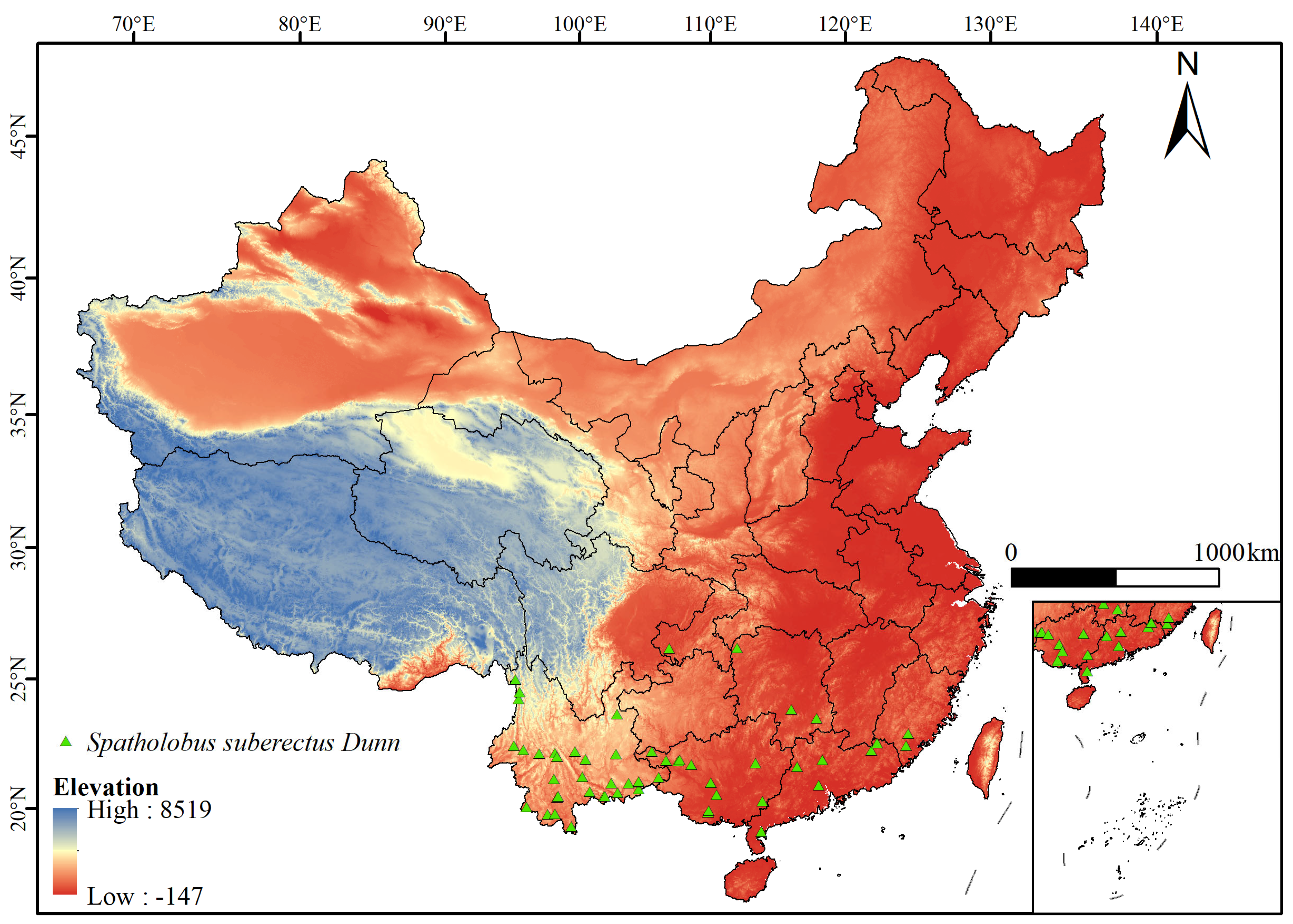



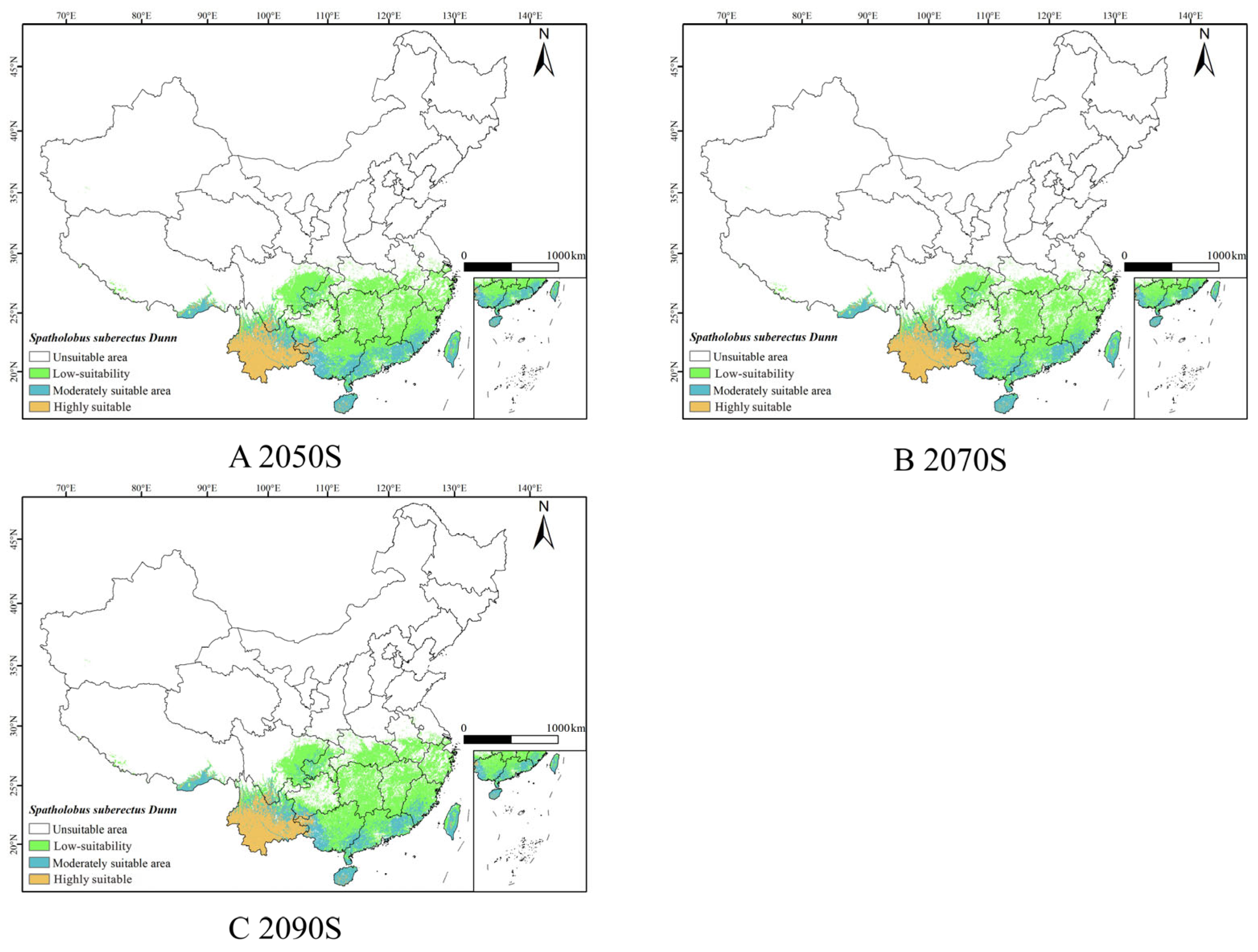

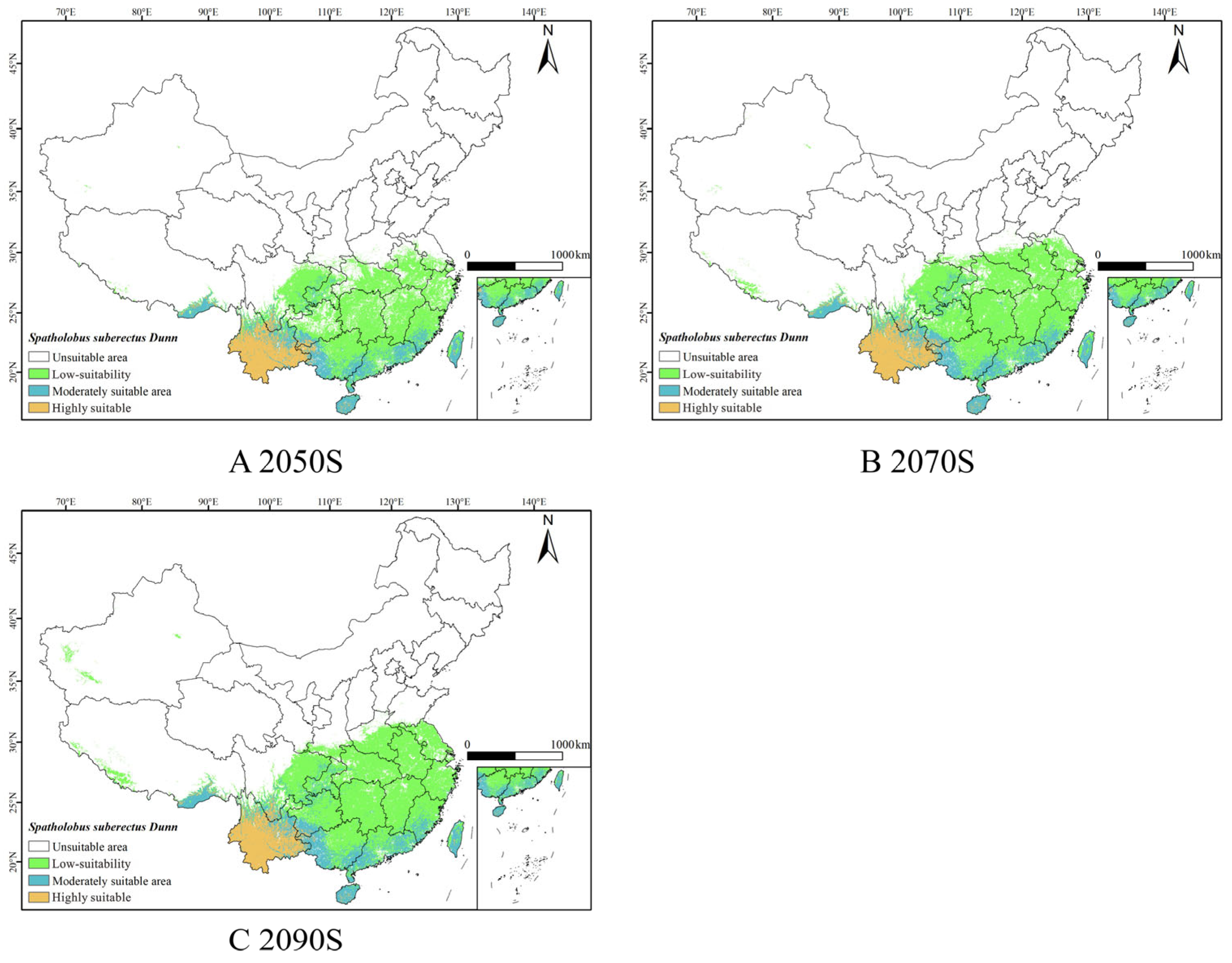

| Environment Variables | Variable | Unit |
|---|---|---|
| gm_lc_v3 | Soil cover type | _ |
| gm_ve_v2 | Vegetation cover percentage | _ |
| hf_v2geo1 | Human footprint and activity impact index | _ |
| annual_mean_uv-b | Annual average ultraviolet radiation | kWh/m2 |
| elev | Altitude | m |
| slope | Slope | ° |
| aspect | Aspect | _ |
| bio01 | Annual average temperature | °C |
| bio03 | Isothermality | _ |
| bio04 | Temperature seasonality | _ |
| bio05 | Maximum temperature of the warmest month | °C |
| bio06 | Minimum temperature of the coldest month | °C |
| bio09 | Average temperature of the driest season | °C |
| bio11 | Average temperature of the coldest season | °C |
| bio17 | Precipitation of the driest season | mm |
| d1_clay | Clay content | cps |
| d1_cn_ratio | Carbon-to-nitrogen ratio | _ |
| d1_elec_cond | Electrical conductivity | _ |
| d1_ph_water | pH level | pH |
| d1_sand | Sand content | kg/m3 |
| d1_swr | Soil moisture status | _ |
| d1_total_n | Total nitrogen content | mg/L |
| d1_usda | Soil texture classification | _ |
| TSS | KAPPA | Evaluation Criteria |
|---|---|---|
| 0 ≤ TSS ≤ 0.4 | 0 ≤ KAPPA ≤ 0.4 | Lose |
| 0.4 < TSS ≤ 0.55 | 0.4 < KAPPA ≤ 0.55 | Normal |
| 0.55 < TSS ≤ 0.7 | 0.55 < KAPPA ≤ 0.7 | Good |
| 0.7 < TSS ≤ 0.85 | 0.7 < KAPPA ≤ 0.85 | Fine |
| 0.85 < TSS | 0.85 < KAPPA | Superb |
Disclaimer/Publisher’s Note: The statements, opinions and data contained in all publications are solely those of the individual author(s) and contributor(s) and not of MDPI and/or the editor(s). MDPI and/or the editor(s) disclaim responsibility for any injury to people or property resulting from any ideas, methods, instructions or products referred to in the content. |
© 2025 by the authors. Licensee MDPI, Basel, Switzerland. This article is an open access article distributed under the terms and conditions of the Creative Commons Attribution (CC BY) license (https://creativecommons.org/licenses/by/4.0/).
Share and Cite
Lin, Y.; Liu, Q.; Lv, S.; Huang, X.; Wei, C.; Li, J.; Guan, Y.; Pan, Y.; Mi, Y.; Cheng, Y.; et al. Assessing the Potential Distribution of the Traditional Chinese Medicinal Plant Spatholobus suberectus in China Under Climate Change: A Biomod2 Ensemble Model-Based Study. Biology 2025, 14, 1071. https://doi.org/10.3390/biology14081071
Lin Y, Liu Q, Lv S, Huang X, Wei C, Li J, Guan Y, Pan Y, Mi Y, Cheng Y, et al. Assessing the Potential Distribution of the Traditional Chinese Medicinal Plant Spatholobus suberectus in China Under Climate Change: A Biomod2 Ensemble Model-Based Study. Biology. 2025; 14(8):1071. https://doi.org/10.3390/biology14081071
Chicago/Turabian StyleLin, Yijun, Quanwei Liu, Shan Lv, Xiaoyu Huang, Chaoyang Wei, Jun Li, Yijie Guan, Yaxuan Pan, Yijia Mi, Yanshu Cheng, and et al. 2025. "Assessing the Potential Distribution of the Traditional Chinese Medicinal Plant Spatholobus suberectus in China Under Climate Change: A Biomod2 Ensemble Model-Based Study" Biology 14, no. 8: 1071. https://doi.org/10.3390/biology14081071
APA StyleLin, Y., Liu, Q., Lv, S., Huang, X., Wei, C., Li, J., Guan, Y., Pan, Y., Mi, Y., Cheng, Y., Yang, X., & Xu, D. (2025). Assessing the Potential Distribution of the Traditional Chinese Medicinal Plant Spatholobus suberectus in China Under Climate Change: A Biomod2 Ensemble Model-Based Study. Biology, 14(8), 1071. https://doi.org/10.3390/biology14081071






